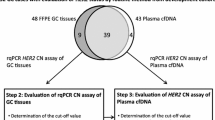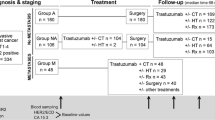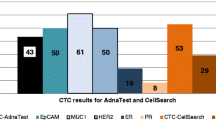Abstract
Background
HER2 (human epidermal growth factor receptor 2) status has been evaluated in breast cancer (BC) tissues by immunohistochemistry or in situ hybridization. We evaluated HER2 copy number (CN) assay in plasma cell-free DNA (cfDNA) from blood samples and compared it with protein measurements of HER2 extracellular domain (ECD) in serum.
Methods
Serum HER2-ECD levels were measured by chemi-luminescence immunoassay using anti-HER2 monoclonal antibodies. Analyses were performed on 120 cases of primary BC, 30 cases of metastatic BC and 34 cases treated by neoadjuvant chemotherapy (NAC). This study was approved by Medical Research Review Advancement No. 1857 for Kumamoto University.
Results
There was a positive correlation between HER2-CN ratios and HER2-ECD levels, in primary (n = 54) and metastatic (n = 30) HER2-positive BC (P = 0.003 and P < 0.001, respectively). HER2-ECD levels were significantly higher in patients with a larger number of metastatic sites (P = 0.02). The usefulness of HER2 levels in discriminating primary and metastatic HER2-positive BC evaluated by ROC curve analysis was better in the HER2-ECD assay than in the HER2-CN assay. In 34 patients who received NAC, there was a small decrease in HER2-CN ratios between before and after NAC (P = 0.10), while there was an obvious decrease in HER2-ECD levels between before and after NAC (P < 0.001).
Conclusion
Compared to HER2-ECD levels, the clinical usefulness of HER2-CN ratio was somewhat inferior. Improved measurement methods and further examination of the association with long-term prognosis and the response to anti-HER2 treatment analyzed by HER2-CN and HER2-ECD assay are required.




Similar content being viewed by others
References
Iwase H, Kurebayashi J, Tsuda H, Iwase T, Yamamoto Y, Ohta T, et al. Clinicopathological analyses of triple negative breast cancer using surveillance data from the Registration Committee of the Japanese Breast Cancer Society. Breast Cancer. 2010;17(2):118–24.
Wu VS, Kanaya N, Lo C, Mortimer J, Chen S. From bench to bedside: What do we know about hormone receptor-positive and human epidermal growth factor receptor 2-positive breast cancer? J Steroid Biochem Mol Biol. 2015;153:45–53.
Slamon DJ, Clark GM, Wong SG, Levin WJ, Ullrich A, McGuire WL. Human breast cancer: correlation of relapse and survival with amplification of the HER-2/neu oncogene. Science. 1987;235(4785):177–82.
Wolff AC, Hammond MEH, Allison KH, Press MF, Ellis IO, Viale G, et al. Human epidermal growth factor receptor 2 testing in breast cancer: American Society of Clinical Oncology/College of American Pathologists clinical practice guideline focused update. J Clin Oncol. 2018;36(20):2105–22.
Yamamoto-Ibusuki M, Yamamoto Y, Fu P, Honda Y, Yamamoto S, Iwase H, et al. Divisional role of quantitative HER2 testing in breast cancer. Breast Cancer. 2015;22(2):161–71.
Wang R, Li X, Zhang H, Wang K, He J. Cell-free circulating tumor DNA analysis for breast cancer and its clinical utilization as a biomarker. Oncotarget. 2017;8(43):75742–55.
Perkins G, Yap TA, Pope L, Cassidy AM, Dukes JP, Riisnaes R, et al. Multi-purpose utility of circulating plasma DNA testing in patients with advanced cancers. PLoS ONE. 2012;7(11):e47020.
Maltoni R, Casadio V, Ravaioli S, Foca F, Tumedei MM, Salvi S, et al. Cell-free DNA detected by “liquid biopsy” as a potential prognostic biomarker in early breast cancer. Oncotarget. 2017;8(10):16642–9.
De Mattos-Arruda L, Caldas C. Cell-free circulating tumour DNA as a liquid biopsy in breast cancer. Mol Oncol. 2016;10(3):464–74.
Takeshita T, Yamamoto Y, Yamamoto-Ibusuki M, Inao T, Sueta A, Iwase H, et al. Prognostic role of PIK3CA mutations of cell-free DNA in early-stage triple negative breast cancer. Cancer Sci. 2015;106(11):1582–9.
Takeshita T, Iwase H. dPCR mutational analyses in cell-free DNA: a comparison with tissues. Methods Mol Biol. 2019;1909:105–18.
Lam L, McAndrew N, Yee M, Fu T, Tchou JC, Zhang H. Challenges in the clinical utility of the serum test for HER2 ECD. Biochim Biophys Acta. 2012;1826(1):199–208.
Wang T, Zhou J, Zhang S, Hu H, Liu B, Liu Y, et al. Meaningful interpretation of serum HER2 ECD levels requires clear patient clinical background, and serves several functions in the efficient management of breast cancer patients. ClinChim Acta. 2016;458:23–9.
Leyland-Jones B, Smith BR. Serum HER2 testing in patients with HER2-positive breast cancer: the death knell tolls. Lancet Oncol. 2011;12(3):286–95.
Gevensleben H, Garcia-Murillas I, Graeser MK, Schiavon G, Osin P, Parton M, et al. Noninvasive detection of HER2 amplification with plasma DNA digital PCR. Clin Cancer Res. 2013;19(12):3276–84.
Taylor SC, Laperriere G, Germain H. Droplet Digital PCR versus qPCR for gene expression analysis with low abundant targets: from variable nonsense to publication quality data. Sci Rep. 2017;7(1):2409.
Hindson BJ, Ness KD, Masquelier DA, Belgrader P, Heredia NJ, Makarewicz AJ, et al. High-throughput droplet digital PCR system for absolute quantitation of DNA copy number. Anal Chem. 2011;83(22):8604–10.
Shoda K, Ichikawa D, Fujita Y, Arita T, Hamada J, Konishi H, et al. Monitoring the HER2 copy number status in circulating tumor DNA by droplet digital PCR in patients with gastric cancer. Gastric Cancer. 2017;20(1):126–35.
Shoda K, Masuda K, Ichikawa D, Imoto I, Otsuji E, Konishi H, et al. HER2 amplification detected in the circulating DNA of patients with gastric cancer: a retrospective pilot study. Gastric Cancer. 2015;18(4):698–710.
Palmirotta R, Lovero D, Cafforio P, Felici C, Mannavola F, Pellè E, et al. Liquid biopsy of cancer: a multimodal diagnostic tool in clinical oncology. TherAdv Med Oncol. 2018;10:1758835918794630.
Dawson SJ, Rosenfeld N, Caldas C. Circulating tumor DNA to monitor metastatic breast cancer. N Engl J Med. 2013;369(1):93–4.
Ran R, Huang W, Liu Y, Shao L, Liu X, Niu Y, et al. Prognostic value of plasma HER2 gene copy number in HER2-positive metastatic breast cancer treated with first-line trastuzumab. Onco Targets Ther. 2020;13:4385–95.
Bramwell VH, Doig GS, Tuck AB, Tomiak A, Perera F, Wilson SM, et al. Changes over time of extracellular domain of HER2 (ECD/HER2) serum levels have prognostic value in metastatic breast cancer. Breast Cancer Res Treat. 2009;114(3):503–11.
Perrier A, Gligorov J, Lefèvre G, Boissan M. The extracellular domain of Her2 in serum as a biomarker of breast cancer. Lab Invest. 2018;98(6):696–707.
Witzel I, Loibl S, von Minckwitz G, Eidtmann H, Fehm T, Khandan F, et al. Predictive value of HER2 serum levels in patients treated with lapatinib or trastuzumab—a translational project in the neoadjuvant GeparQuinto trial. Br J Cancer. 2012;107(6):956–60.
Acknowledgements
This work was supported in part by a Grant-in-Aid (project no.2459191000) for Scientific Research from the Ministry of Education, Science, and Culture of Japan.
Author information
Authors and Affiliations
Corresponding author
Ethics declarations
Conflict of interest
Takashi Takeshita reports personal fees from Eisai, personal fees from Eli Lilly, personal fees from AstraZeneca, personal fees from Pfizer, personal fees from Kyowa-Kirin.Yutaka Yamamoto reports grants and personal fees from Daiichi-Sankyo, grants and personal fees from Eisai, grants and personal fees from Eli Lilly, grants and personal fees from Takeda, personal fees from Sysmex, personal fees from GE Health Care Japan, personal fees from AstraZeneca, grants and personal fees from Pfizer, grants and personal fees from Novartis, grants and personal fees from Nihon Kayaku, grants and personal fees from Kyowa-Kirin, grants and personal fees from Taiho, grants and personal fees from Chugai as outside the submitted work; and is a board member of the Japanese Breast Cancer Society. Hirotaka Iwase reports grants and personal fees from Daiichi-Sankyo, grants and personal fees from Eizai, grants and personal fees from Pfizer, personal fees from Takeda, personal fees from AstraZeneca, grants and personal fees from Chugai-Roche, personal fees from Nihonkayaku. Shi Qui, Aiko Sueta, Mai Tomiguchi, Lisa Goto-Yamaguchi and Ikuko Suzu have no COI disclosures.
Additional information
Publisher's Note
Springer Nature remains neutral with regard to jurisdictional claims in published maps and institutional affiliations.
Supplementary Information
Below is the link to the electronic supplementary material.
About this article
Cite this article
Qui, S., Takeshita, T., Sueta, A. et al. Analysis of plasma HER2 copy number in cell-free DNA of breast cancer patients: a comparison with HER2 extracellular domain protein level in serum. Breast Cancer 28, 746–754 (2021). https://doi.org/10.1007/s12282-020-01212-x
Received:
Accepted:
Published:
Issue Date:
DOI: https://doi.org/10.1007/s12282-020-01212-x




